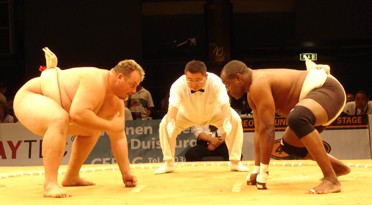| Yokozuna Comparisons Joe Kuroda |

 |
| Amateur Sumo's Global Aspirations Courtesy: International Sumo Federation |

 |
| Rikishi of Old Joe Kuroda |

 |
| Heya Peek Barbara Ann Klein |

 |
| SFM Interview Mark Buckton |

 |
| Sumo 101 Barbara Ann Klein |

 |
| Photo Bonanza See the Haru |
 |
| Haru Basho Review Lon Howard |

 |
| Lower Division Rikishi Mikko Mattila |

 |
| Natsu Basho Forecast Mark Buckton |

 |
| Kimarite Focus Mikko Mattila |

 |
| Sumo in Print Mark Buckton |

 |
| Kokugi Connections Todd Lambert |

 |
| Fan Debate Facilitator – Lon Howard |

 |
| SFM Cartoons Benny Loh & Stephen Thompson |

 |
| Let’s Hear From You What was it that |

 |
| Readers’ Letters See what some |

 |
Sumo Quiz
The Quizmaster
Answer the Qs and win yourself next basho’s banzuke.

Stanley Somerville (RSA) gegen James B. Thompson (USA) – World Games 2005
 Mittelgewicht Jugend – bis zu 100 kg
Mittelgewicht Jugend – bis zu 100 kg Schwergewicht Jugend – mehr als 100 kg
Schwergewicht Jugend – mehr als 100 kgSeit 1980 gibt es internationale Amateursumo-Turniere und 1992 wurde erstmal eine Sumoweltmeisterschaft unter der Schirmherrschaft der IFS durchgeführt. Die 73 Teilnehmer kamen aus 25 Ländern. Seitdem sind die jährlich veranstalteten Weltmeisterschaften immer gewachsen. auch für die 14. Weltmeiserschaften ab 15. Oktober in Sakai City erwartet die IFS einen Erfolg.
Des Weiteren versucht die IFS Sumo als olympische Disziplin zu etablieren. Es gibt 3 Sportbehörden, die mit dem IOC verbunden sind:. ARISF (Association of IOC Recognized International Sports Federations), IWGA (International World Games Association), und GAISF (General Association of International Sports Federations). Eines der Kriterien für eine Aufnahme zu den olympischen Spielen ist eine Mitgliedschaft bei allen 3 Organisationen.
Anlässlich der Winterspiele in
Weiter
 Leichtgewicht Männer – bis zu 85 kg
Leichtgewicht Männer – bis zu 85 kg Mittelgewicht Männer – bis zu 115 kg
Mittelgewicht Männer – bis zu 115 kg Schwergewicht Männer – mehr als 115 kg
Schwergewicht Männer – mehr als 115 kg Leichtgewicht Frauen – bis zu 65 kg
Leichtgewicht Frauen – bis zu 65 kg Mittelgewicht Frauen – bis zu 80 kg
Mittelgewicht Frauen – bis zu 80 kg Schwergewicht Frauen – mehr als 80 kg
Schwergewicht Frauen – mehr als 80 kg Leichtgewicht Jugend – bis zu 75 kg
Leichtgewicht Jugend – bis zu 75 kg